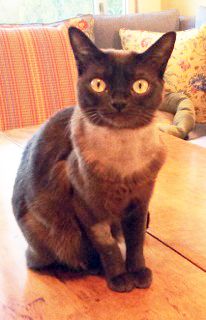Veterinary, human surgeons collaborate to save cat
Balloon dilation used to correct rarely seen congestive heart failure.

Vanilla Bean, recovering well from her surgery. Photo courtesy of UC Davis.Vanilla Bean, a 1-year-old female Burmese cat from Mill Valley, California, was brought to veterinary cardiologist Kristin MacDonald, DVM, PhD, DACVIM, for respiratory distress. MacDonald diagnosed her with a rare congenital heart defect that does not allow blood to flow properly through the chambers. This improper flow can cause too much blood to collect in one chamber, create pressure, enlarge it and ultimately lead to congestive heart failure.
MacDonald, a former University of California, Davis, cardiology resident, was familiar with a special technique for correction reported only once before by Josh Stern, DVM, PhD, DACVIM. MacDonald referred the case to UC Davis where Stern is on the faculty at the Veterinary Medical Teaching Hospital (VMTH). Stern accepted the case and, after an echocardiogram, confirmed MacDonald's diagnosis.
Assisted by four other doctors-both veterinary surgeons and human cardiologists-the team began the delicate procedure of opening the stenosis with a hybrid cutting balloon dilatation. Vanilla Bean's chest cavity was opened to expose the heart, and the delicate process of positioning the catheters and balloons within Vanilla Bean's heart began.
Transesophageal echocardiography helped Stern visualize where he was in the heart and monitored the success of each technique that was utilized. “This is an extremely uncommon technique employed in veterinary medicine,” Stern says. “It's even more rarely employed in cats due to their small size.”
Stern was able to place the balloon across the defect. The balloon cuts the membrane to allow blood to flow through it regularly.
While the balloon dilatation was successful, Vanilla Bean's surgery was not without complication. She lost a lot of blood during the procedure. Transfusions were swiftly performed with blood from the hospital's feline donor base. Due to the blood loss, though, Vanilla Bean suffered an acute kidney injury. During a week of hospitalization, however, her creatinine levels slowly decreased every day.
Vanilla Bean was able to go home eight days after her surgery. A week later, she returned to the VMTH for a check-up. Her creatinine levels, while still not in the normal range, continued to drop. An echocardiogram showed the balloon dilatation was successful.
Vanilla Bean is no longer in congestive heart failure and is off all medications. Her creatinine levels have returned to the normal range. Stern expects her to make a complete recovery.